The Nephroureteral Stent Market is estimated to be valued at USD 3.1 billion in 2025 and is projected to reach USD 5.5 billion by 2035, registering a compound annual growth rate (CAGR) of 5.9% over the forecast period.
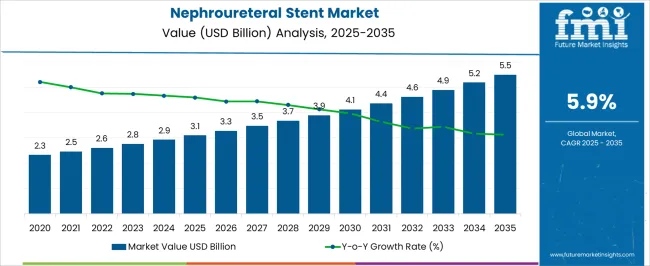
| Metric | Value |
|---|---|
| Nephroureteral Stent Market Estimated Value in (2025 E) | USD 3.1 billion |
| Nephroureteral Stent Market Forecast Value in (2035 F) | USD 5.5 billion |
| Forecast CAGR (2025 to 2035) | 5.9% |
The Nephroureteral Stent market is demonstrating steady growth as the prevalence of urological disorders, kidney stones, and urinary tract obstructions continues to rise globally. Increasing adoption of minimally invasive procedures, coupled with advancements in stent design and biomaterial technologies, is fueling market expansion. Healthcare providers are focusing on improving patient outcomes and reducing recovery times, which has increased the use of nephroureteral stents in both acute and chronic conditions.
The growing aging population, which is more susceptible to kidney-related disorders, is further driving demand. Additionally, rising healthcare spending, improved diagnostic rates, and increased awareness of treatment options are contributing to market growth. The introduction of stents with enhanced biocompatibility, reduced encrustation, and improved durability has strengthened clinical acceptance.
Regulatory approvals of innovative designs and growing access to urology services in emerging economies are expected to support long-term market expansion As the need for efficient, reliable, and patient-friendly treatment options grows, the nephroureteral stent market is anticipated to maintain its growth trajectory, with technological innovation serving as a key driver.
The nephroureteral stent market is segmented by product, application, and geographic regions. By product, nephroureteral stent market is divided into Retrograde Stents, Antegrade Stents, and Internal (Double-J) Stents. In terms of application, nephroureteral stent market is classified into Lithotripsy, Ureteroscopy, Ureteroenoscopy, and Percutaneous Nephrolithotomy. Regionally, the nephroureteral stent industry is classified into North America, Latin America, Western Europe, Eastern Europe, Balkan & Baltic Countries, Russia & Belarus, Central Asia, East Asia, South Asia & Pacific, and the Middle East & Africa.
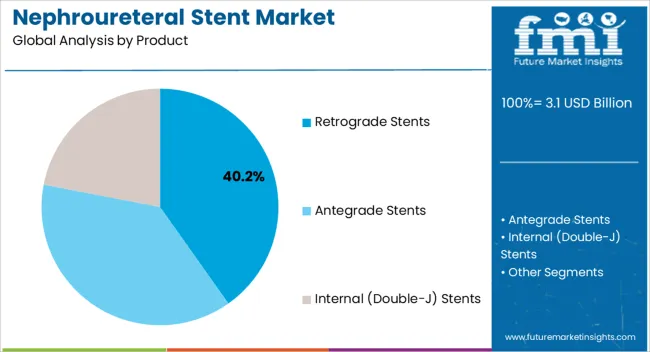
The retrograde stents product segment is projected to account for 40.2% of the market revenue in 2025, making it the leading product category. Growth in this segment is being driven by its effectiveness in treating urinary tract obstructions and facilitating smooth urine flow from the kidneys to the bladder. Retrograde stents are favored by urologists due to their ease of insertion, high success rates in minimally invasive procedures, and reduced patient discomfort.
Advances in material design, such as the use of polyurethane and silicone coatings, are improving flexibility, biocompatibility, and resistance to encrustation, thereby enhancing patient outcomes. Hospitals and specialty clinics are increasingly relying on retrograde stents because they allow for safe placement using cystoscopic techniques, ensuring shorter procedure times and faster recovery.
The cost-effectiveness of retrograde stents compared to alternative interventions has further bolstered their adoption As the prevalence of kidney stone cases and related urological conditions continues to rise, demand for retrograde stents is expected to strengthen, supporting their leading role in the nephroureteral stent market.
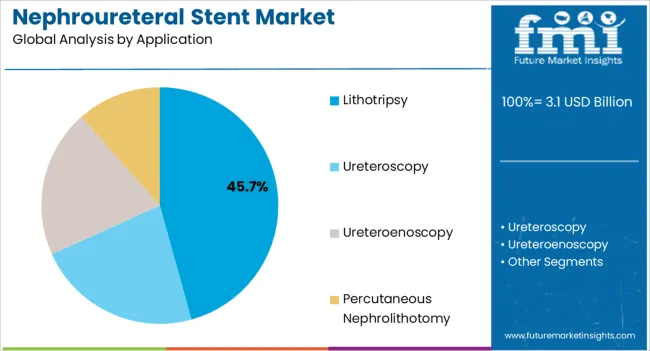
The lithotripsy application segment is anticipated to hold 45.7% of the market revenue share in 2025, positioning it as the leading application area. Its growth is being driven by the rising incidence of kidney stones and the increasing preference for non-invasive or minimally invasive stone removal procedures. Nephroureteral stents play a vital role in lithotripsy by ensuring proper drainage and preventing complications such as ureteral obstruction or infection following stone fragmentation.
The ability of stents to facilitate smooth passage of residual fragments and reduce postoperative discomfort has reinforced their importance in lithotripsy procedures. Growing adoption of advanced lithotripsy techniques, including extracorporeal shock wave lithotripsy and laser-based methods, is further increasing reliance on stent placement for procedural success.
Hospitals and urology centers are increasingly integrating stent placement as a standard step in lithotripsy protocols to minimize risks and improve patient outcomes With kidney stone prevalence rising due to lifestyle changes and dietary factors, the lithotripsy application segment is expected to remain dominant, supported by innovation in stent design and increased treatment adoption worldwide.
A nephroureteral stent, sometimes as well called ureteric stent, it’s a thin tube inserted into the ureter to prevent or treat obstruction of the urine flow due to conditions such as kidney stone, tumors, infections, etc.
A nephroureteral stent is specially designed a soft tube 10-12 inches in length that is placed in the ureter for draining urine from the kidney to the urinary bladder. The length of the stents used in adult patients varies from 24 to 30 cm additionally, stents come in differing diameters or gauges, to fit different size ureters.
The stent is usually inserted with the aid of a cystoscope.
Normally a person can have nephroureteral stents for not more than 3 to 6 months. If left for longer duration, there can be a chance of secondary complications like stone formation, urethral infection, etc. which makes removal of stents difficult. Several market players are researching to overcome the issue of biofilm formation and mineralogical encrustation.
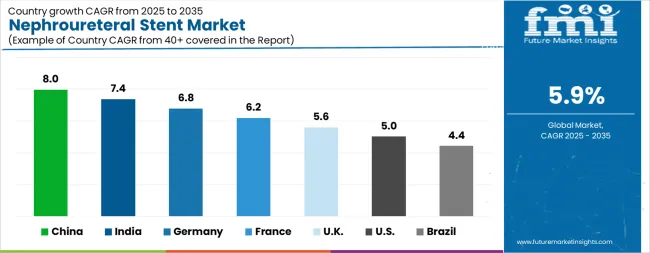
| Country | CAGR |
|---|---|
| China | 8.0% |
| India | 7.4% |
| Germany | 6.8% |
| France | 6.2% |
| UK | 5.6% |
| USA | 5.0% |
| Brazil | 4.4% |
The Nephroureteral Stent Market is expected to register a CAGR of 5.9% during the forecast period, exhibiting varied country level momentum. China leads with the highest CAGR of 8.0%, followed by India at 7.4%. Developed markets such as Germany, France, and the UK continue to expand steadily, while the USA is likely to grow at consistent rates. Brazil posts the lowest CAGR at 4.4%, yet still underscores a broadly positive trajectory for the global Nephroureteral Stent Market. In 2024, Germany held a dominant revenue in the Western Europe market and is expected to grow with a CAGR of 6.8%. The USA Nephroureteral Stent Market is estimated to be valued at USD 1.1 billion in 2025 and is anticipated to reach a valuation of USD 1.9 billion by 2035. Sales are projected to rise at a CAGR of 5.0% over the forecast period between 2025 and 2035. While Japan and South Korea markets are estimated to be valued at USD 141.9 million and USD 104.0 million respectively in 2025.
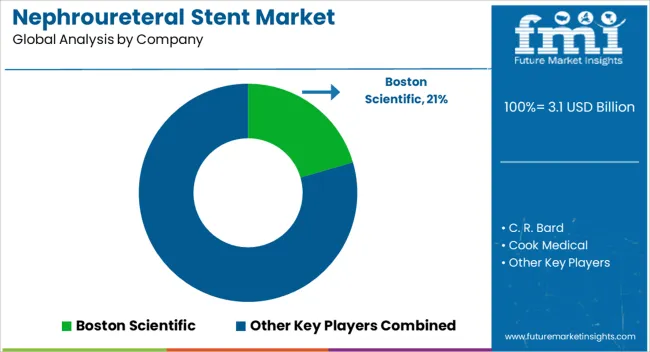
| Item | Value |
|---|---|
| Quantitative Units | USD 3.1 Billion |
| Product | Retrograde Stents, Antegrade Stents, and Internal (Double-J) Stents |
| Application | Lithotripsy, Ureteroscopy, Ureteroenoscopy, and Percutaneous Nephrolithotomy |
| Regions Covered | North America, Europe, Asia-Pacific, Latin America, Middle East & Africa |
| Country Covered | United States, Canada, Germany, France, United Kingdom, China, Japan, India, Brazil, South Africa |
| Key Companies Profiled | Boston Scientific, C. R. Bard, Cook Medical, Medline Industries, Pnn Medical, Allium Medical, B. Braun, and Dextronix |
The global nephroureteral stent market is estimated to be valued at USD 3.1 billion in 2025.
The market size for the nephroureteral stent market is projected to reach USD 5.5 billion by 2035.
The nephroureteral stent market is expected to grow at a 5.9% CAGR between 2025 and 2035.
The key product types in nephroureteral stent market are retrograde stents, antegrade stents and internal (double-j) stents.
In terms of application, lithotripsy segment to command 45.7% share in the nephroureteral stent market in 2025.






Our Research Products

The "Full Research Suite" delivers actionable market intel, deep dives on markets or technologies, so clients act faster, cut risk, and unlock growth.

The Leaderboard benchmarks and ranks top vendors, classifying them as Established Leaders, Leading Challengers, or Disruptors & Challengers.

Locates where complements amplify value and substitutes erode it, forecasting net impact by horizon

We deliver granular, decision-grade intel: market sizing, 5-year forecasts, pricing, adoption, usage, revenue, and operational KPIs—plus competitor tracking, regulation, and value chains—across 60 countries broadly.

Spot the shifts before they hit your P&L. We track inflection points, adoption curves, pricing moves, and ecosystem plays to show where demand is heading, why it is changing, and what to do next across high-growth markets and disruptive tech

Real-time reads of user behavior. We track shifting priorities, perceptions of today’s and next-gen services, and provider experience, then pace how fast tech moves from trial to adoption, blending buyer, consumer, and channel inputs with social signals (#WhySwitch, #UX).

Partner with our analyst team to build a custom report designed around your business priorities. From analysing market trends to assessing competitors or crafting bespoke datasets, we tailor insights to your needs.
Supplier Intelligence
Discovery & Profiling
Capacity & Footprint
Performance & Risk
Compliance & Governance
Commercial Readiness
Who Supplies Whom
Scorecards & Shortlists
Playbooks & Docs
Category Intelligence
Definition & Scope
Demand & Use Cases
Cost Drivers
Market Structure
Supply Chain Map
Trade & Policy
Operating Norms
Deliverables
Buyer Intelligence
Account Basics
Spend & Scope
Procurement Model
Vendor Requirements
Terms & Policies
Entry Strategy
Pain Points & Triggers
Outputs
Pricing Analysis
Benchmarks
Trends
Should-Cost
Indexation
Landed Cost
Commercial Terms
Deliverables
Brand Analysis
Positioning & Value Prop
Share & Presence
Customer Evidence
Go-to-Market
Digital & Reputation
Compliance & Trust
KPIs & Gaps
Outputs
Full Research Suite comprises of:
Market outlook & trends analysis
Interviews & case studies
Strategic recommendations
Vendor profiles & capabilities analysis
5-year forecasts
8 regions and 60+ country-level data splits
Market segment data splits
12 months of continuous data updates
DELIVERED AS:
PDF EXCEL ONLINE
Stent Delivery Systems Market Size and Share Forecast Outlook 2025 to 2035
Stent Graft Balloon Catheter Market Insights - Growth & Forecast 2025 to 2035
Existent Gum Steam Generator Market
Gel Stent Market Size and Share Forecast Outlook 2025 to 2035
Persistent Epithelial Defect Management Market Size and Share Forecast Outlook 2025 to 2035
Venous Stents Market Size and Share Forecast Outlook 2025 to 2035
Aortic Stent Grafts Market Analysis - Size, Share, and Forecast 2025 to 2035
Enteral Stents Market
Ureteral Stent Market Size and Share Forecast Outlook 2025 to 2035
Branched Stent Graft Market Size and Share Forecast Outlook 2025 to 2035
Coronary Stents Market Insights – Trends, Growth & Forecast 2025-2035
Nephrology Stents and Catheters Market
Non-Vascular Stents Market Growth - Trends & Forecast 2025 to 2035
Neurovascular Stent Retrievers Market Size and Share Forecast Outlook 2025 to 2035
Bioabsorbable Stents Market Growth – Trends & Forecast 2025 to 2035
Advanced Persistent Threat Protection Market
Gastrointestinal Stent Market Growth - Trends & Forecast 2025 to 2035
Thoracic Vascular Stent Grafts Market Trends and Forecast 2025 to 2035
Peripheral Vascular Stent Market Analysis - Size, Trends & Forecast 2025 to 2035
Industrial Analysis of Coronary Stent in India Size and Share Forecast Outlook 2025 to 2035

Thank you!
You will receive an email from our Business Development Manager. Please be sure to check your SPAM/JUNK folder too.
Chat With
MaRIA